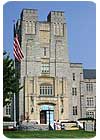
On April 16, 2007, a Virginia Tech University student opened fire on campus.
In the aftermath of the Virginia Tech University campus shooting on Monday, April 16, 2007, security experts across the country have chimed in with their opinions and evaluations of the situation. While crisis plans on campuses and universities might involve first responders, campus administrators, campus public safety, S.W.A.T. teams, students, media and families — dealers and systems integrators also can take part in planning for such crises by encouraging their customers to take a proactive approach to security and by assisting campuses and universities in assessing their risk and determining their security needs.
Steven Healy, director of public safety at Princeton University, Princeton, N.J. and president of the International Association of Campus Law Enforcement Administrators (IACLEA), and other security experts SDM spoke with, recommend the use of threat and risk assessment tools (such as the one on IACLEA’s Web site: www.iaclea.org) as a starting point for a college or university in evaluating its current plans and systems.
“We also suggest that many of the integrators and [security] manufacturers can be very useful in conducting assessments as well. Private consultants can also play a role,” Healy added.
Patrick Fiel, public safety advisor – education at ADT Security Services, says that mass notification systems, like the one that ADT offers, are a great area of interest for universities and campuses across the country.
Unfortunately, a university’s total security package depends on the budget available, and security dealers and systems integrators needs to be prepared to help schools and campuses find electronic security needs that are appropriate for what they want to protect — and that fit into the organization’s budget.
Chuck Burdick, director of campus safety and security at iXP, Lawrenceville, N.J., and a 25-year veteran of fire service for the Littleton, Colo., Fire Department who was one of the first responders to the scene of the Columbine High School shooting in 1999, said that it is too early to tell what we will learn from the Virginia Tech incident, but eventually changes will happen. One of the simplest security measures that Burdick said saved many lives at Columbine was the fact that the classroom doors locked from the inside — which kept the shooters from entering many classrooms and areas of the school.
One of the lessons reinforced by the Virginia Tech incident, said Fiel, is how important communication is. Barry Nixon, executive director of the California-based National Institute for Prevention of Workplace Violence, agreed. Organizations and campuses alike need to be able to get a hold of people on campus and off, have a strategic plan in place for such a violent situation, and administrators and security personnel need to be trained in exactly how to deploy the technology, Nixon said.
In addition to access control and mass communication systems, many of those interviewed by SDM emphasized cameras and the importance of integration. “You have to prepare for internal and external issues. Cameras can detect before, during and after an incident,” Fiel said.
Nixon also said that for security dealers and systems integrators, forming alliances and relationships with associations and industry organizations, such as the National Institute for Prevention of Workplace Violence or IACLEA, can be a helpful aid in learning about and addressing the specific needs of a market.